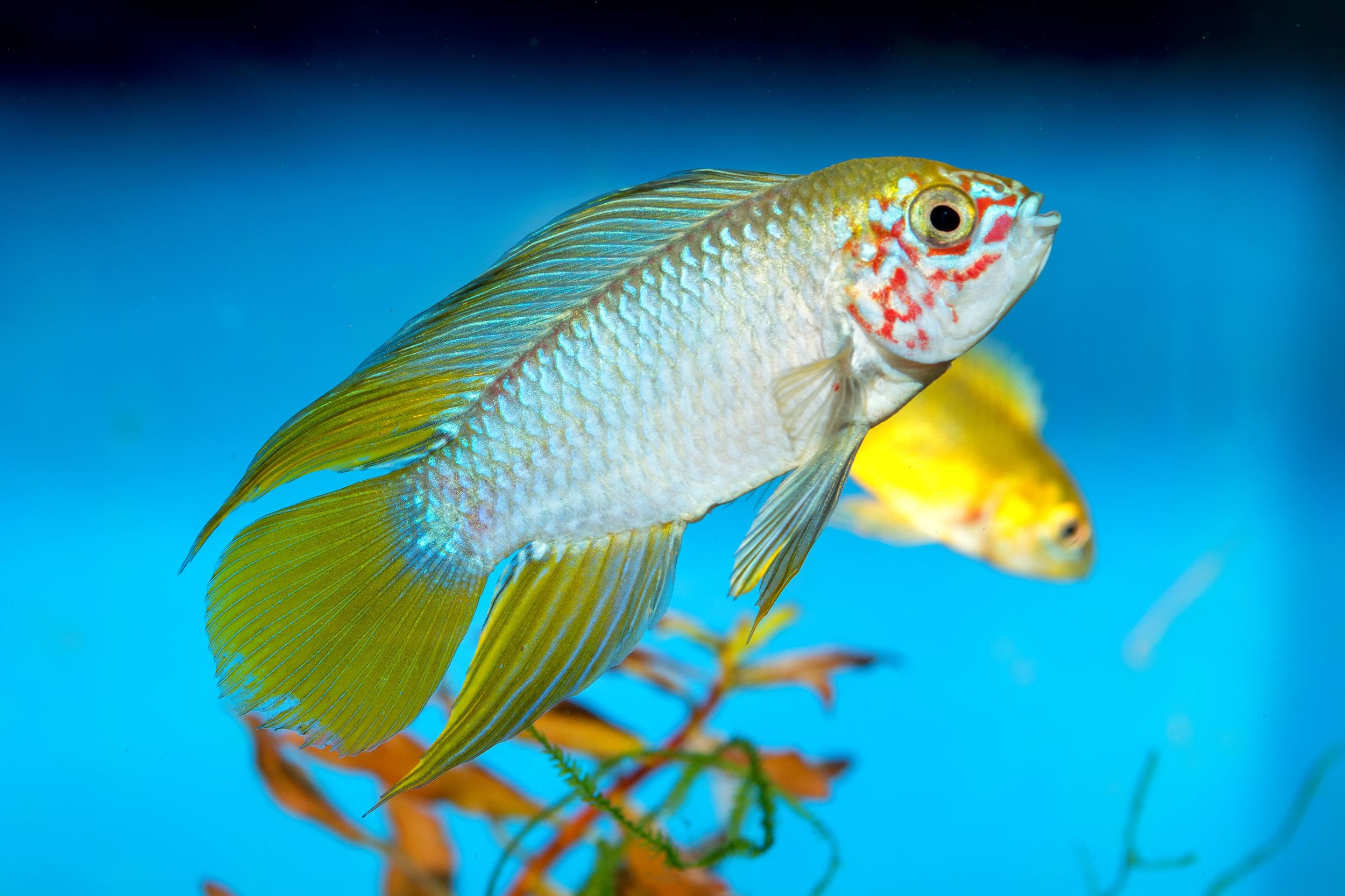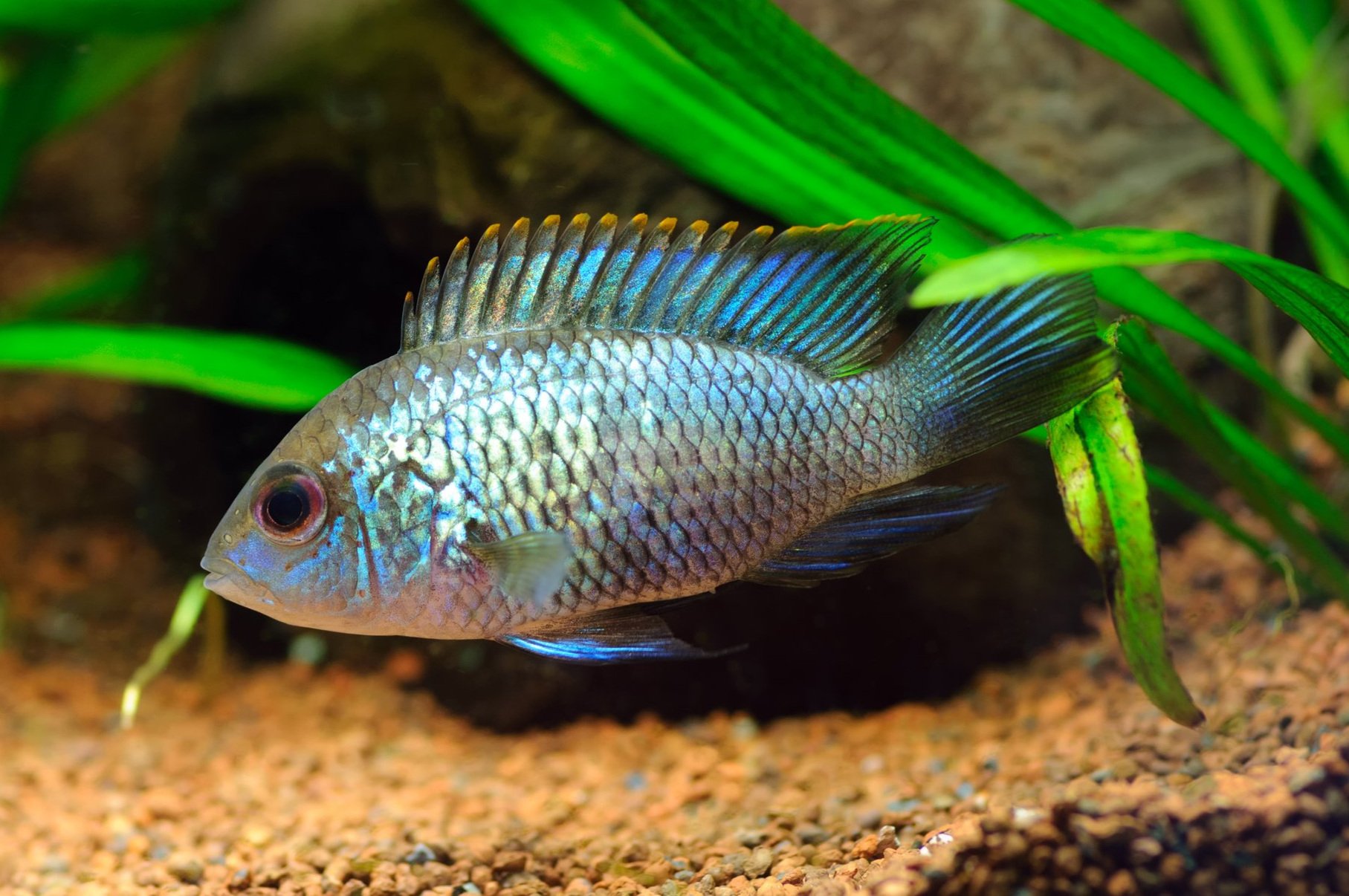Altum Angel 'San Felipe' F1-M
The Altum Angelfish, scientifically known as Pterophyllum altum, is a stunning, deep-bodied freshwater cichlid native to the Orinoco and Rio Negro river basins in Colombia, Venezuela, and Brazil. Known for its impressive height, graceful fins, and distinct vertical banding, the Altum is the largest and most challenging species of angelfish to keep, requiring pristine water conditions and a well-maintained environment.
Physically, Pterophyllum altum has a laterally compressed body with an exceptionally tall dorsal and anal fin, giving it a striking, triangular appearance. It is distinguished from the common angelfish (Pterophyllum scalare) by its more pronounced body depth, longer fin extensions, and deeper forehead notch. Its base color is silvery with three to four bold vertical black stripes that can intensify depending on mood and stress levels. Altum Angelfish can reach a body length of around 7 inches (18 centimeters) but, including their extended fins, they can grow up to 15 inches (38 centimeters) in height.
In the aquarium, Altum Angelfish require a minimum tank size of 90 to 120 gallons, with a height of at least 24 inches (60 centimeters) to accommodate their vertical growth. They thrive in heavily planted aquariums with driftwood, tall plants, and open swimming spaces. The addition of leaf litter, such as Indian almond leaves, can help replicate their natural blackwater environment. These fish prefer low to moderate lighting, which enhances their natural colors and helps reduce stress.
Water parameters should be soft and acidic, with a temperature range of 82 to 90°F (28 to 32°C), a pH between 4.5 and 6.5, and very low hardness (1-5 dGH). Strong filtration and regular water changes are essential, as Altums are highly sensitive to poor water quality and sudden parameter fluctuations. They require highly oxygenated, slow-moving water, similar to their natural river habitats.
Feeding Pterophyllum altum requires a high-protein diet. They readily accept live and frozen foods, including bloodworms, blackworms, brine shrimp, daphnia, and mysis shrimp. High-quality cichlid pellets and flakes can be offered, but they should be supplemented with fresh foods to ensure proper nutrition. They may take time to adjust to prepared foods, particularly when first introduced to captivity.
Altum Angelfish are generally peaceful, but they can become territorial during breeding. They do best in groups of at least five to six individuals to prevent aggression between dominant and subordinate fish. Suitable tank mates include peaceful, non-nippy species such as rummynose tetras, cardinal tetras, pencilfish, hatchetfish, and small, peaceful catfish like Corydoras and Otocinclus. Avoid keeping them with aggressive cichlids or fin-nipping species.
Breeding Pterophyllum altum is exceptionally difficult in captivity, with very few documented successes outside of specialized breeding facilities. They are substrate spawners, laying eggs on vertical surfaces such as broad leaves or driftwood. However, most captive Altums are wild-caught, and they require precise conditions, including blackwater parameters, soft acidity, and warm temperatures, to trigger breeding behaviors. Their fry are delicate and require specialized care, including live foods such as newly hatched brine shrimp.
Overall, Pterophyllum altum (Altum Angelfish) is a challenging but highly rewarding species, best suited for experienced aquarists who can provide the specific water conditions and space required for their long-term care. Their majestic appearance, graceful movements, and unique behaviors make them one of the most sought-after angelfish species in the aquarium hobby.
The Altum Angelfish, scientifically known as Pterophyllum altum, is a stunning, deep-bodied freshwater cichlid native to the Orinoco and Rio Negro river basins in Colombia, Venezuela, and Brazil. Known for its impressive height, graceful fins, and distinct vertical banding, the Altum is the largest and most challenging species of angelfish to keep, requiring pristine water conditions and a well-maintained environment.
Physically, Pterophyllum altum has a laterally compressed body with an exceptionally tall dorsal and anal fin, giving it a striking, triangular appearance. It is distinguished from the common angelfish (Pterophyllum scalare) by its more pronounced body depth, longer fin extensions, and deeper forehead notch. Its base color is silvery with three to four bold vertical black stripes that can intensify depending on mood and stress levels. Altum Angelfish can reach a body length of around 7 inches (18 centimeters) but, including their extended fins, they can grow up to 15 inches (38 centimeters) in height.
In the aquarium, Altum Angelfish require a minimum tank size of 90 to 120 gallons, with a height of at least 24 inches (60 centimeters) to accommodate their vertical growth. They thrive in heavily planted aquariums with driftwood, tall plants, and open swimming spaces. The addition of leaf litter, such as Indian almond leaves, can help replicate their natural blackwater environment. These fish prefer low to moderate lighting, which enhances their natural colors and helps reduce stress.
Water parameters should be soft and acidic, with a temperature range of 82 to 90°F (28 to 32°C), a pH between 4.5 and 6.5, and very low hardness (1-5 dGH). Strong filtration and regular water changes are essential, as Altums are highly sensitive to poor water quality and sudden parameter fluctuations. They require highly oxygenated, slow-moving water, similar to their natural river habitats.
Feeding Pterophyllum altum requires a high-protein diet. They readily accept live and frozen foods, including bloodworms, blackworms, brine shrimp, daphnia, and mysis shrimp. High-quality cichlid pellets and flakes can be offered, but they should be supplemented with fresh foods to ensure proper nutrition. They may take time to adjust to prepared foods, particularly when first introduced to captivity.
Altum Angelfish are generally peaceful, but they can become territorial during breeding. They do best in groups of at least five to six individuals to prevent aggression between dominant and subordinate fish. Suitable tank mates include peaceful, non-nippy species such as rummynose tetras, cardinal tetras, pencilfish, hatchetfish, and small, peaceful catfish like Corydoras and Otocinclus. Avoid keeping them with aggressive cichlids or fin-nipping species.
Breeding Pterophyllum altum is exceptionally difficult in captivity, with very few documented successes outside of specialized breeding facilities. They are substrate spawners, laying eggs on vertical surfaces such as broad leaves or driftwood. However, most captive Altums are wild-caught, and they require precise conditions, including blackwater parameters, soft acidity, and warm temperatures, to trigger breeding behaviors. Their fry are delicate and require specialized care, including live foods such as newly hatched brine shrimp.
Overall, Pterophyllum altum (Altum Angelfish) is a challenging but highly rewarding species, best suited for experienced aquarists who can provide the specific water conditions and space required for their long-term care. Their majestic appearance, graceful movements, and unique behaviors make them one of the most sought-after angelfish species in the aquarium hobby.
The Altum Angelfish, scientifically known as Pterophyllum altum, is a stunning, deep-bodied freshwater cichlid native to the Orinoco and Rio Negro river basins in Colombia, Venezuela, and Brazil. Known for its impressive height, graceful fins, and distinct vertical banding, the Altum is the largest and most challenging species of angelfish to keep, requiring pristine water conditions and a well-maintained environment.
Physically, Pterophyllum altum has a laterally compressed body with an exceptionally tall dorsal and anal fin, giving it a striking, triangular appearance. It is distinguished from the common angelfish (Pterophyllum scalare) by its more pronounced body depth, longer fin extensions, and deeper forehead notch. Its base color is silvery with three to four bold vertical black stripes that can intensify depending on mood and stress levels. Altum Angelfish can reach a body length of around 7 inches (18 centimeters) but, including their extended fins, they can grow up to 15 inches (38 centimeters) in height.
In the aquarium, Altum Angelfish require a minimum tank size of 90 to 120 gallons, with a height of at least 24 inches (60 centimeters) to accommodate their vertical growth. They thrive in heavily planted aquariums with driftwood, tall plants, and open swimming spaces. The addition of leaf litter, such as Indian almond leaves, can help replicate their natural blackwater environment. These fish prefer low to moderate lighting, which enhances their natural colors and helps reduce stress.
Water parameters should be soft and acidic, with a temperature range of 82 to 90°F (28 to 32°C), a pH between 4.5 and 6.5, and very low hardness (1-5 dGH). Strong filtration and regular water changes are essential, as Altums are highly sensitive to poor water quality and sudden parameter fluctuations. They require highly oxygenated, slow-moving water, similar to their natural river habitats.
Feeding Pterophyllum altum requires a high-protein diet. They readily accept live and frozen foods, including bloodworms, blackworms, brine shrimp, daphnia, and mysis shrimp. High-quality cichlid pellets and flakes can be offered, but they should be supplemented with fresh foods to ensure proper nutrition. They may take time to adjust to prepared foods, particularly when first introduced to captivity.
Altum Angelfish are generally peaceful, but they can become territorial during breeding. They do best in groups of at least five to six individuals to prevent aggression between dominant and subordinate fish. Suitable tank mates include peaceful, non-nippy species such as rummynose tetras, cardinal tetras, pencilfish, hatchetfish, and small, peaceful catfish like Corydoras and Otocinclus. Avoid keeping them with aggressive cichlids or fin-nipping species.
Breeding Pterophyllum altum is exceptionally difficult in captivity, with very few documented successes outside of specialized breeding facilities. They are substrate spawners, laying eggs on vertical surfaces such as broad leaves or driftwood. However, most captive Altums are wild-caught, and they require precise conditions, including blackwater parameters, soft acidity, and warm temperatures, to trigger breeding behaviors. Their fry are delicate and require specialized care, including live foods such as newly hatched brine shrimp.
Overall, Pterophyllum altum (Altum Angelfish) is a challenging but highly rewarding species, best suited for experienced aquarists who can provide the specific water conditions and space required for their long-term care. Their majestic appearance, graceful movements, and unique behaviors make them one of the most sought-after angelfish species in the aquarium hobby.







